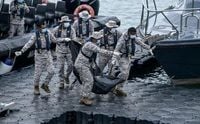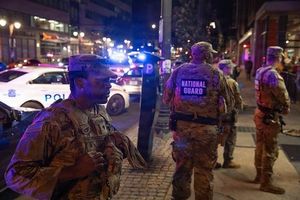On the morning of November 6, 2025, the waters near Thailand’s Tarutao island—close to the Malaysia-Thailand border—became the scene of yet another migrant tragedy. A boat carrying about 70 undocumented migrants, most of them Rohingya refugees fleeing persecution in Myanmar, capsized while attempting the perilous journey to Malaysia. The incident, which would claim at least 36 lives and leave many more missing, has cast a harsh spotlight on the ongoing plight of the Rohingya and the region’s struggle to manage the complex web of migration, trafficking, and humanitarian crisis that surrounds them.
According to the Malaysian Maritime Enforcement Agency (MMEA), the search-and-rescue operation, which lasted ten days, was officially called off on November 17. Zainudin Mohd Zuki, the agency’s deputy operations director for Kedah and Perlis, explained the decision at a press conference: “We have examined all factors, including the size of the area, assets deployment, duration of the operation and information about the incident. However, if there are any new leads or indications, we will reassess and reactivate the operation to search for the remaining missing victims.” (AFP)
Rescuers from both Malaysia and Thailand scoured a vast area—about 1,750 square nautical miles, roughly eight times the size of Singapore—with 19 vessels and more than 300 personnel. Malaysian teams recovered 29 bodies, while their Thai counterparts found seven more. In total, 14 survivors—mainly Rohingya and Bangladeshi citizens—were pulled from Malaysian waters. For those who made it, the ordeal was harrowing. Survivor Iman, who hails from Rakhine state in Myanmar, recounted to Reuters, “I saw one person die. They drowned.” He had clung to floating wreckage for days before being washed up on a Malaysian island and rescued on November 11.
The ill-fated vessel was reportedly just one of at least two boats that left Myanmar as part of a larger group of approximately 300 people. The fate of a second boat, believed to be carrying around 230 passengers, remains unknown. Malaysian police have reported it as missing, and fears for its passengers’ safety continue to mount.
Malaysia, with its relatively affluent economy compared to neighboring countries, has long been a destination for migrants from across Asia. Many, including the Rohingya, find work in construction, agriculture, and other essential sectors, often without legal documentation. According to the United Nations Refugee Agency (UNHCR), Malaysia currently hosts around 189,700 Myanmar refugees and asylum seekers, a significant portion of them Rohingya. The agency recorded 196 Rohingya arrivals in Malaysia in the past year alone, underscoring the relentless flow of desperate people seeking safety and opportunity.
The journey, however, is fraught with danger. Human trafficking syndicates, preying on the desperation of refugees, facilitate hazardous sea crossings in overloaded boats. The United Nations estimates that since February 2022, some 22,460 Rohingya refugees have embarked on dangerous sea journeys from Bangladesh and Myanmar. Between January and early November 2025, more than 5,300 Rohingya attempted to flee by boat, with more than 600 reported dead or missing. Chris Lewa, director of the Arakan Project which monitors these voyages, told Reuters it typically takes “a week to 10 days to reach Malaysian waters. Sometimes, boats would have also stopped to pick up Rohingya refugees from Rakhine.”
The reasons for such perilous journeys are rooted in decades of violence, discrimination, and targeted persecution. The Rohingya have been denied basic rights in Myanmar—citizenship, healthcare, education, and work. The largest displacement took place in 2017, when more than 750,000 people fled into Bangladesh. Since then, thousands have remained in limbo in refugee camps or have risked their lives at sea, driven by a lack of legal pathways to safety and the hope of reuniting with family members or finding work. As UNHCR put it, “Limited legal pathways for refugees to seek safety and reunite with family members drive them to risky channels, with traffickers preying on desperation through false promises.”
Malaysia’s refugee system is under strain. The country’s maritime agencies are stretched thin, tasked with combating not only human trafficking but also piracy, smuggling, illegal fishing, and sea robbery. Associate Professor Dr Mohammad Zaki Ahmad of Universiti Utara Malaysia, an expert on maritime affairs, believes the root of the problem is not simply operational but structural. “Malaysia needs an integrated governance framework that sets out joint procedures, command structures and a single maritime picture,” he told a local newspaper. The current system, he argued, is hampered by overlapping powers and a lack of coordination among maritime police, customs, fisheries, and the navy—remnants of a time before the MMEA was formed in 2004 by merging seven agencies.
Workshops and ad hoc meetings, Dr Zaki said, cannot replace a permanent, unified system. He noted that the MMEA’s legislation has not kept pace with its evolving responsibilities, leaving officers on the ground to grapple with huge and often conflicting demands. “The heart of Malaysia’s maritime problems is not the officers on the ground but the system under which they work,” he emphasized.
Yet, as Dr Zaki and others point out, the solution does not lie solely in tightening Malaysia’s maritime security. The persecution of the Rohingya is a regional and international crisis, with roots in Myanmar’s post-independence history. The United Nations Security Council (UNSC), despite having the authority to intervene, has been criticized for its lack of political will. The International Criminal Court (ICC) has opened an investigation into Myanmar’s military leader Min Aung Hlaing for alleged crimes against humanity, but progress has stalled. ASEAN, the regional bloc, is constrained by its non-interference policy and has struggled to pressure Myanmar’s military government.
In the aftermath of the tragedy, Malaysian authorities launched a joint operation with Interpol and Aseanapol to target the smuggling network believed to be behind the incident. UNHCR, for its part, has offered support to Malaysian authorities, “to identify the international protection needs of the survivors and to extend humanitarian assistance.”
The human toll of these journeys is not just a matter of numbers. Behind every statistic is a family torn apart, a community in anguish. Mohamed Ibrahim, another refugee who fled on a boat to Malaysia, left his wife and three young children behind. His brother, Mohammed Younus, told Reuters from a refugee camp in Bangladesh, “If I had known, I would never have let him go.”
As the search for survivors ends and attention turns to the broader crisis, the story of the Rohingya boat tragedy near the Malaysia-Thailand border is a stark reminder of the urgent need for regional cooperation, humanitarian support, and above all, lasting solutions for one of Southeast Asia’s most persecuted peoples.




